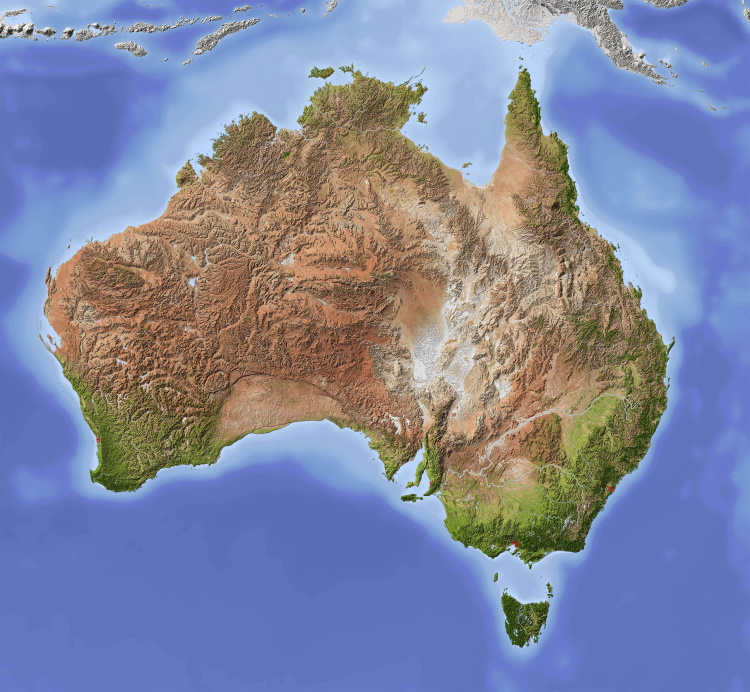

If there is a demand for a forensic capability, there’s someone willing to sell it to a police department (and a jury).


If there is a demand for a forensic capability, there’s someone willing to sell it to a police department (and a jury).
The real reason behind all the gelatin salad abominations is that after gelatin was first discovered/isolated, it was very costly to produce, but new technology made it much more affordable.
Isolating gelatin requires long cook times (which require lots of fuel) at ideally fairly low temperatures. Then there needs to be some level of filtration to make it as flavorless as possible, and then dehydration to sheets or a powder.
Finally, to actually make one of these “salads”, you need refrigeration.
Production of gelatin was industrialized to make it much cheaper, and refrigerators became normal household appliances. You went from gelatin being only really used in “fine dining” to something you could do at home. In the same era, pineapple went from being a fruit that only the rich could get to something anyone could, so it went through a similar explosion of popularity.
The alternative funny answer is that the company that sold gelatin, Knox, was run by a husband and wife, and all the crazy stuff didn’t start until the husband died, so either he was holding her back, or once she lost her husband, she thought everyone else should, too.


I think full modern-strength liquor is relatively new-ish (500-1000 years). I’m just thinking back to the meme of the wikipedia article on the “timeline of Irish inventions” that has the invention of whiskey and then a gap of 300 years before they invented anything else.


“Fortified” means that liquor is added which acts as a preservative and it also stops further fermentation so you can have more sugar left in the wine. Oftentimes, herbs are added, too, which also acts a preservative.
In beer, IPAs are similar in that greater amounts of hops were added so it could survive the trip to India with less chance of spoiling.


I’ve made wine (and a lot of beer). It’s not hard, and people have been doing it for ages, but creating a good, consistent product does rely on chemistry/biology knowledge that they wouldn’t have had back then.
I suspect that a lot of the mystique around wine (like the idea that terroir is magic) is just down to the fact that a few hundred years ago, most wine/beer was trash, and the only stuff we’d consider “good” by modern standards is just down to luck that a batch didn’t get infected with the wrong yeast/bacteria, or exposed to too much oxygen, or a style that is meant to be drunk young (vinho verde) or oxidized (sherry).
There’s probably good reason that much of the wine that was aged/transported long distance a couple hundred years ago was fortified (Madeira, Port, sherry, vermouth, etc.).
Millenia of selective breeding have changed grapes, too. Without knowing for certain, my guess would be that on average, the sugar concentration in the raw grape juice would be roughly the same as now, but relying on wild yeasts or polycultures would not ferment as completely, so the final product would have lower ABV and higher sugar.
In beer, the actual grain and malting technology has greatly changed over time. 150 years ago, German immigrants to America couldn’t brew the lighter styles they were used to because American grain was much higher in protein so they had to dilute it with corn/rice. Older grain had a higher propensity for certain defects, too. Basically you had more inconsistency back in the day, and also just some things that were different.


People usually don’t log stuff that they see every day. So a person who lives in Oregon (statistically more likely to be in doug-fir country) goes east and notices that a different tree predominates and they want to know what it is, they’ll log it.
Personally, I log stuff that I don’t normally see cause there’s a chance that it’s either: a rare native plant, a native plant on the edge of its range, or a non-native. Those are all things that I’m less likely to know off the top of my head, and I think it’s probably more important to tag for scientific purposes.


I can’t stand the amount of times my phone tries to force apostrophes into places that don’t need them. So many plurals that should just end in " s " become " 's ". “Were” also gets changed to “we’re” despite it not making any sense in context.
Also, separate issue, but it seems like autocorrect can almost never comprehend the possibility that I hit the wrong button for the first letter of a word.


Agreed. Sometimes, a sentence that ends with a preposition sounds weird. Oftentimes, a sentence that has been completely rearranged to not end in a preposition sounds weird.


It depends on what you are cooking, but I usually do. Maillard and caramelization reactions will not occur in the temperatures that your pressure cooker will get to. If there’s an option to add those flavors to a meal, I’m going to do it. There are cuisines, though, where that’s not traditional or desired.
Think about rice, for example. Sometimes, you want more delicate fluffy plain white rice, while other times you want to do a pilaf technique where you brown it first. Neither is “better”, just different.
Generally, if an ingredient is susceptible to overcooking, I’m not going to pressure cook it. Rice is easy since the grain size is consistent, but something like chicken breasts, I’m not going to pressure cook.
Adding more high temp cooking will drive out more moisture, but sometimes that’s worth it. I would never eat a steak without a search, for example.


Not only is it fine, but it’s the most common (and i would say most correct) way to write scientific papers.
The tone of scientific papers is usually supposed to focus on the science, not the scientist, so you have “reagent A was mixed with reagent B”, not “I mixed reagent A and reagent B”.
An added bonus is that it prevents having to assign credit to each and every step of a procedure, which would be distracting. E.G., “Alice added 200 ml water to the flask while Bob weighed out 5 g of sodium hydroxide and added it to the flask”.


Yeah, it’s really frustrating when someone with higher body fat that floats like a cork tries to tell you how to do it.
Technique can’t overcome density. I will say that I got slightly better at it after learning to SCUBA dive (or maybe I just got fatter). In scuba, you move up and down in the water column by adjusting the range of your breathing. You basically try to get your neutrally boyant setpoint at 50% lung capacity. To go down, you try to control your breathing from 0-50% and to go up, you breathe from 50-100%. It made me slightly better at keeping my lungs really topped up with air.
To float, I basically have to hold my lungs at max capacity, and then exhale-inhale as fast as possible, which is unnatural and takes concentration. I usually have to use my arms for a little bit of upward thrust through that breath.
There’s no lungs in my legs, so those will sink no matter what. People claim you can “use your core” or some other BS to keep your legs afloat, but the fact of the matter is that if your upper body is positively buoyant and your lower body is negatively buoyant, there will be a rotational moment pulling your legs down, and it can only be counteracted by external application of force (i.e., kicking your feet). I can either float on my back with a mild amount of kicking, or i can do like a face-in-water deadman float, and just pull my head out of the water occasionally to quickly breathe.


I’m going to disagree with everyone here. Loads of people throughout history have learned to swim by literally being thrown in. It’s not a good way to learn, but people do it. Even babies can do it.
Given a little bit of reading first, you’d do just fine. Yeah, the motions might be a little off cause it’s hard to learn a complex movement from a book, but it would be good enough.


You’re getting downvoted for saying something sorta close to true, but not exactly. I agree strongly with everything you said here, though.
Generally, with any complex human-machine interface, you want to cast as wide of a net for accommodation as possible because there are so many variables that come into play.
Like if you are putting together a basketball team, you probably want a bunch of tall dudes, but you never know how many Muggsy Bogues’s are out there unless you let everyone play.
For a fighter pilot, would you rather have a female with greater ability to distinguish color, or a male that can pull higher g’s? It’s impossible to say what specific traits would lead to the best outcome in all possible engagements.
Even things like colorblindness can be a positive in situations because camouflage can stick out to colorblind people. Some types of deafness comes with immunity to motion sickness.


I’m not sure. I know in a lot of those places, the rationale is that the terrain is too flat, so rifle bullets can travel too far.
The problem is that I don’t know if that actually corresponds to increased risk of death. It sounds plausible, but idk if there are real stats to back it up.
A quick search for some plausible data turned up California’s official stats, and going back a few years, I never saw more than 5 deaths in a year. Extrapolating the rate to the whole US, that’s like 50 per year. Other sources just say “less than 100 per year for the whole US”.
Without a specific study, it’s just as plausible to attribute the fatalities to sheer proximity of the shooter to the victim rather than bullets traveling far. Bigger targets are easier to hit. Just looking at the California data, which includes injuries, this seems to bear out, and most injuries and fatalities are due to close range shotgun bird hunting (i.e. the Dick Cheney).
And really, if you wanted to completely eliminate the risk of rifle bullets traveling further than intended, you could mandate the use of any elevated shooting position (which some places do for archery).


Here’s an example: Delaware only allows shotgun, pistol/pistol caliber long guns, and muzzleloader, no true rifle.
https://www.eregulations.com/delaware/hunting/deer-seasons
Connecticut only allows rifle on private land.
https://portal.ct.gov/deep/hunting/2025-connecticut-hunting-and-trapping-guide/deer-hunting#PVSHOT
Iowa has no rifle allowed.
https://www.iowadnr.gov/things-do/hunting-trapping/iowa-hunting-seasons
Lots of states have restrictions against modern (and by modern, i mean bottlenecked) rifle rounds, and if you want to use a rifle, you have to either find a 150 year old cowboy gun, or buy a really expensive new gun using one of several specialized cartridges that cost like $2 a round.
And then when it comes down to it, if you live in a state where it is legal to hunt with a regular rifle, you end up finding that half the time any public land that you can hunt on is restricted to archery only, so unless you happen to be a large landowner, you can’t hunt with a rifle.


That’s not true. With no controls, there is no significant difference in tolerance by sex. When controlled for height, females have lower tolerance than males. https://pubmed.ncbi.nlm.nih.gov/3753357/


There are a lot of differences between how the US and how Australia do hunting. For one, there is no commercial deer/elk harvest in the US. Commercially sold venison can only be from farmed deer/elk. I think deer leather can be sold, but there are a lot of hoops to go through.
Also, in the US, most hunting regulations exist not for ethical or conservation purposes but to prevent people from being able to subsistence hunt. They wanted hunting to be a rich man’s game like in the UK. The existence of hunting seasons is a good example. Another is regulations on method of take; for example, you often must use outdated equipment like bows and muzzleloaders, and the use of modern, effective rifles is severely curtailed. Compare that to Australia where you can use night vision/thermal scopes and rifles with supressors, and i believe there is no “hunting season”.
The reality is that both countries have an overpopulation of large herbivores in areas, and the answer anti-hunting people give is the reintroduction of large carnivores. While we should do that in more rural areas, it’s not feasible in urban/suburban areas where deer proliferate.
Many municipalities actually have to pay to have deer culled, and they do that rather than making it easier for people to hunt.
Tl;dr, i think there are some things I like better about how Australia handles hunting, but theres also things about the US’s method i like.
This sort of thing happens all the time, and it’s usually subject to some level of debate. Just look at the ponderosa pine (pinus ponderosa. Some say there is one species with multiple subspecies, some say they are just different varieties, some say that they are different species, or some are and some arent, etc.
So many of the shitty laws that get passed like this have blatant loopholes, though I dont think that’s really the appropriate term. It’s because in order for these shitbags to not say the quiet part out loud, they have to write it in such a general way that it can be easily defeated.
Just look at any of the states with “chemtrail” laws. The laws ban the intentional release of substances that modify the climate via changes to solar radiation absorption or the weather. They are intended to prevent anyone from undertaking any efforts to combat climate change, though it’s clear to anyone with a brain that the law clearly applies to the burning of fossil fuels.
Unfortunately, too many of our elected officials (and appointees, civil servants, etc.) are gutless, and will not follow the letter of these laws.
A good politician would do exactly what you said: build bike lanes, and say they secondary benefits are x, y, z. If anyone has trouble with that, let them argue it in court.